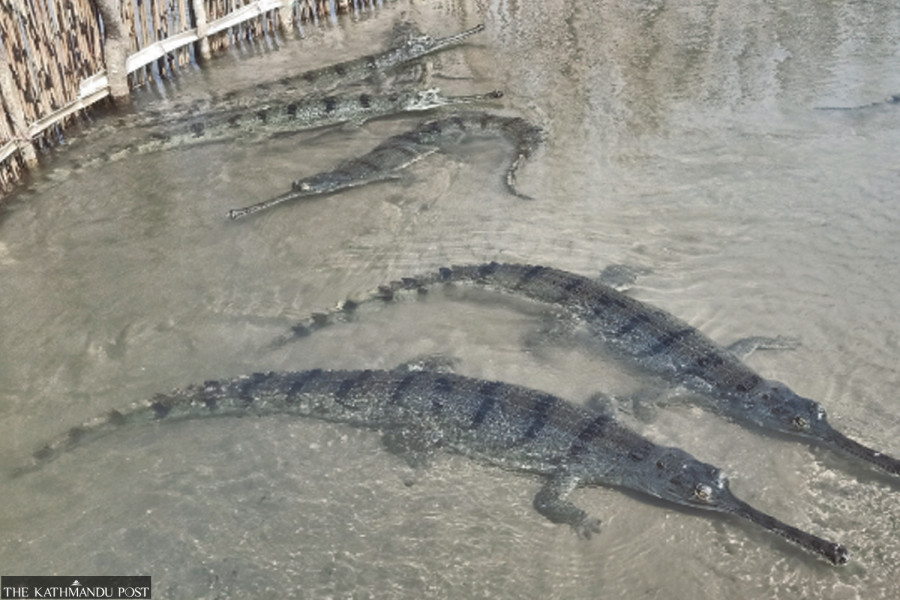National
25 gharials from Chitwan’s breeding centre translocated to Shuklaphanta
1,887 gharials that grew up in the centre have been released in various rivers so far. But their survival rate is very low.
Bhawani Bhatta & Ramesh Kumar Paudel
As many as 25 gharials—a critically endangered species of crocodile—have been shifted to Shuklaphanta from the breeding centre in the Chitwan National Park (CNP). The translocated gharials were released in the Chaudhar river that passes through Shuklaphanta National Park (SNP) in Kanchanpur district on Saturday.
“A soft enclosure has been set up by using reeds on the river bank. The translocated gharials will breach the reeds’ fence and enter into the river within a few days,” said Pramod Bhattarai, senior conservation officer at the SNP. According to him, the ‘soft enclosure’ was set up so that the gharials will be adopted in the new place before they enter the natural habitat.
According to conservationists, a 6km-long area in the Chaudhar river from Piterghat to Ghohikunda is suitable for gharials. “A team of conservationists and technicians stays in a tent pitched near the place where the gharials were released and closely monitors the animals for five days. Later, the team will monitor the gharials by using drone cameras,” said Manoj Air, conservation officer at the SNP who has been directly involved in the gharial translocation.
The gharials fitted with radio tags were brought to Shuklaphanta in wooden boxes from the gharial breeding centre in Kasara, Chitwan. They were released after around 46 hours. According to Air, the gharials—three male and 22 female—are aged four to five years. The Department of National Parks and Wildlife Conservation has a plan to translocate 50 gharials to Shuklaphanta. Twenty-five other gharials will be shifted to Shuklaphanta next year, says SNP.
According to conservationists, gharials are found in some rivers of Nepal, India, Bangladesh, Bhutan, Myanmar and Pakistan with the Rapti and Narayani rivers being their major natural habitats. This species—the only surviving member of the Gavialidae family—is found in the Kaligandaki, Saptakoshi, Babai and Karnali rivers as well in small numbers. The gharial population, which was estimated to be between 5,000 and 10,000 worldwide during the 1940s, declined by almost 96 percent to below 200 in 1976.
The gharials were found in the Chaudhar river until 1995. The Department of National Parks and Wildlife Conservation conducted a feasibility study for the gharial relocation in the Chaudhar river. A five-member study team led by Shyam Kumar Shah carried out the study from the Pitarghat to Radhapur areas along the river. Based on the study report, the department decided to relocate the gharials in the Chaudhar river.
The gharials, according to the conservationists, live only in freshwater rivers and fish is its main food. “The gharials were shifted successfully as planned. We now have challenges for their conservation in the new habitat,” said Air.
The Chitwan National Park set up a gharial breeding centre at Kasara in 1978, aiming to conserve the crocodile species by hatching its eggs and releasing them in the rivers when they grow up to two metres in length. The centre has seen some success. There were just 80 gharials in the country before the breeding centre was established.
A total of 1,887 gharials that grew up in the breeding centre have been released in various rivers as of now. But the survival rate of those released gharials is very low. According to Ganesh Prasad Tiwari, conservation officer at the CNP, the estimated population of gharials across the nation is around 300. The gharials that grew up in the breeding centre are generally released in the natural habitat after the baby gharials become 150 centres in length.

As per the data available at the Chitwan National Park, a total of 1,152 gharials were released in the Rapti river while 419 were released in the Narayani river. Similarly, 115 gharials were released in Saptakoshi, 110 in Babai, 41 in Karnali and 35 in Kaligandaki at different times.
“However, the gharials are sighted only in the Rapti, Narayani, Babai and Karnali rivers,” said Dil Bahadur Pun Purja, chief conservation officer at Chitwan National Park. According to him, a total of 265 gharials—152 in the Rapti river and 113 in the Narayani river—were found during a recent count held some two months ago.
The gharial has been enlisted as a protected species in Nepal. Conservationists say amid multiple challenges in gharial conservation, the most worrying are human activities, river pollution and depletion in number of fish.
“The river pollution, shortage of fish and extraction of riverbed materials are the main challenges of gharial conservation in the country,” said conservationist Ramprit Yadav, who was the chief conservation officer at the Chitwan National Park when the gharial breeding centre was established. Yadav suggested launching an awareness drive and implementing existing legal provision effectively for the gharial conservation.
Anyone found guilty of killing or hunting the endangered gharial faces a fine of Rs100,000 to Rs500,000 or imprisonment of one to ten years, or both.
The use of fishing nets that might trap gharials is another challenge in gharial conservation in the country. To counter this, Chitwan National Park has banned the use of fishing nets in the river. Conservationists say there’s some consolation to take from this but it’s not nearly enough to increase the population of this imperiled species.
Conservationists in the Shuklaphanta National Park are optimistic for the successful survival of the gharials in the Chaudhar river. “The park will leave no stone unturned to protect the gharials. We are quite hopeful for the survival of these gharials in the wild here in Shuklaphanta,” said Bhattarai.
Similarly, a male captive elephant has also been shifted to Shuklaphanta from the Chitwan National Park. The four-year-old jumbo named Simsar Gaj arrived in Shuklaphanta on Friday. With this, the Shuklaphanta National Park, located in the southwestern corner of Nepal, now has a total of nine captive elephants.




 5.44°C Kathmandu
5.44°C Kathmandu
1.jpg)








%20(1).jpg&w=300&height=200)





